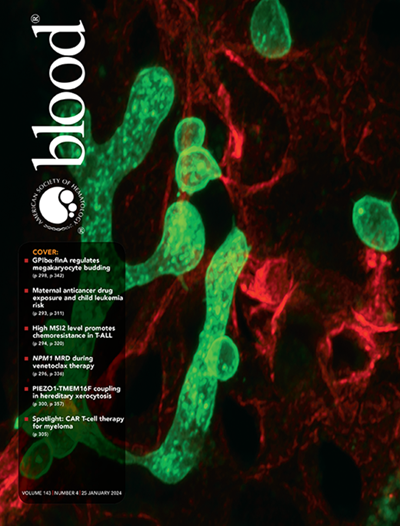一项全基因组筛选发现Runx2是造血干细胞扩增和t细胞承诺的一种新的调节因子。
IF 23.1
1区 医学
Q1 HEMATOLOGY
引用次数: 0
摘要
自我更新的多能造血干细胞(hsc)是一种罕见但重要的细胞群,可以在移植后重建整个血液和免疫系统。由于其罕见性,很难全面研究调节HSC活性的机制。然而,最近使用聚乙烯醇基培养基的造血干细胞和祖细胞(HSPC)培养方法的改进现在促进了大规模的体外造血干细胞扩增。在这里,我们在原代小鼠HSPCs中进行了全基因组CRISPR敲除(KO)筛选,以发现新的体外扩增调节因子。筛选发现Runx2是HSC扩增的强负调节因子,我们通过离体和体内试验验证了这一点。Runx2的缺失使HSPC培养中免疫表型hsc的频率增加了约3倍。在扩增后,这些Runx2-KO hsc在移植试验中以高出5倍的水平移植。非培养的Runx2- ko hsc也显示出增强的重构潜力,但Runx2的缺失并未改变血液参数。然而,值得注意的是,Runx2- ko hsc的t细胞重构减少,我们进一步通过体外和体内实验验证了Runx2在t细胞承诺中的额外作用。总之,我们已经确定了Runx2在HSC中的多方面作用,作为HSC自我更新的负调节因子和t细胞承诺的促进因子。这些结果将有助于理解造血的转录调控和改善造血干细胞的治疗。本文章由计算机程序翻译,如有差异,请以英文原文为准。
A genome-wide screen identifies Runx2 as a novel regulator of hematopoietic stem cell expansion and T-cell commitment.
Self-renewing multipotent hematopoietic stem cells (HSCs) are a rare but important cell population which can reconstitute the entire blood and immune system following transplantation. Due to their rarity, it has been difficult to comprehensively study the mechanisms regulating HSC activity. However, recent improvements in hematopoietic stem and progenitor cell (HSPC) culture methods using polyvinyl alcohol-based media now facilitate large-scale ex vivo HSC expansion. Here we performed a genome-wide CRISPR knockout (KO) screen in primary mouse HSPCs to discover novel regulators of ex vivo expansion. The screen identified Runx2 as a strong negative regulator of HSC expansion, which we validated using ex vivo and in vivo assays. Loss of Runx2 increased the frequency of immunophenotypic HSCs in HSPC cultures by ~3-fold. Following expansion, these Runx2-KO HSCs engrafted at ~5-fold higher levels in transplantation assays. Non-cultured Runx2-KO HSCs also displayed enhanced reconstitution potential, but loss of Runx2 did not alter blood parameters. Notably however, T-cell reconstitution was diminished from Runx2-KO HSCs, and we further validated an additional role for Runx2 in T-cell commitment using ex vivo and in vivo assays. In summary, we have identified a multifaceted role for Runx2 in HSCs, as a negative regulator of HSC self-renewal and as a facilitator of T-cell commitment. These results will contribute understanding transcriptional regulation of hematopoiesis and improve HSC therapies.
求助全文
通过发布文献求助,成功后即可免费获取论文全文。
去求助
来源期刊

Blood
医学-血液学
CiteScore
23.60
自引率
3.90%
发文量
955
审稿时长
1 months
期刊介绍:
Blood, the official journal of the American Society of Hematology, published online and in print, provides an international forum for the publication of original articles describing basic laboratory, translational, and clinical investigations in hematology. Primary research articles will be published under the following scientific categories: Clinical Trials and Observations; Gene Therapy; Hematopoiesis and Stem Cells; Immunobiology and Immunotherapy scope; Myeloid Neoplasia; Lymphoid Neoplasia; Phagocytes, Granulocytes and Myelopoiesis; Platelets and Thrombopoiesis; Red Cells, Iron and Erythropoiesis; Thrombosis and Hemostasis; Transfusion Medicine; Transplantation; and Vascular Biology. Papers can be listed under more than one category as appropriate.
 求助内容:
求助内容: 应助结果提醒方式:
应助结果提醒方式:


